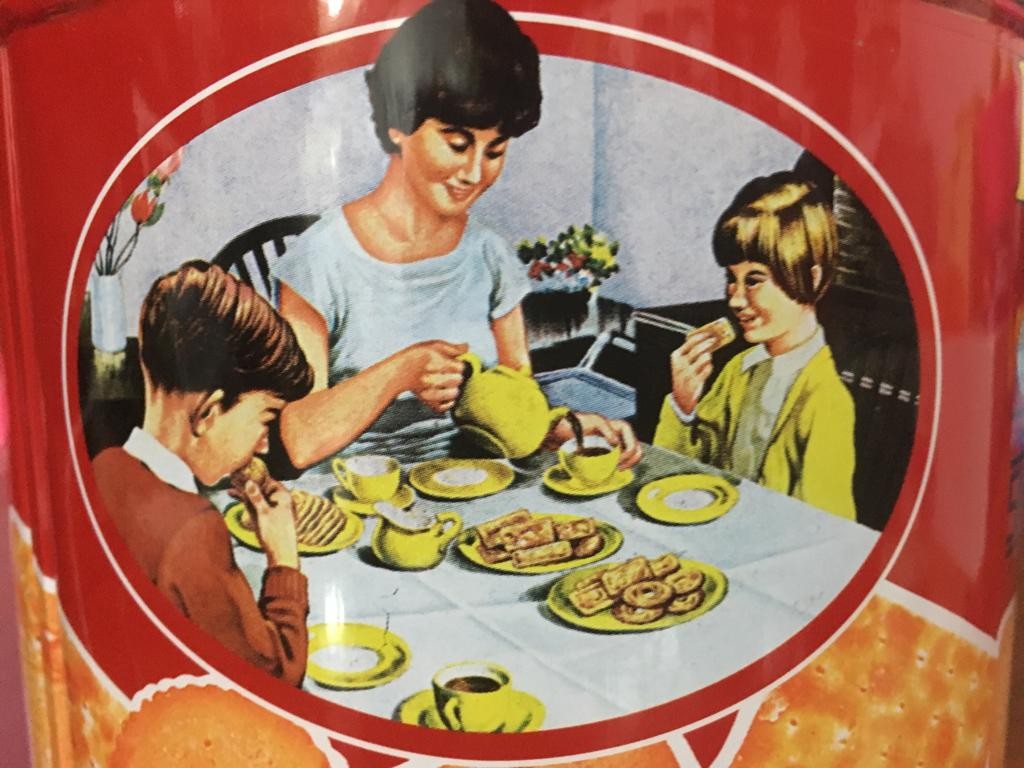Khong Guan cookie tin family mystery gets new explanation this Idul Fitri
Change Size
 Painted by Bernardus Prasodjo when he was an art student at Bandung Institute of Technology (ITB) in the 1970s, the family portrait depicting a mother, her son, and her daughter indulging in tea-time with an assortment of Khong Guan cookies has been appropriated as a comical Internet meme by the predominantly millennial Indonesian users of popular social networking sites in recent years. (JP/-)
Painted by Bernardus Prasodjo when he was an art student at Bandung Institute of Technology (ITB) in the 1970s, the family portrait depicting a mother, her son, and her daughter indulging in tea-time with an assortment of Khong Guan cookies has been appropriated as a comical Internet meme by the predominantly millennial Indonesian users of popular social networking sites in recent years. (JP/-)
A
mong the several Indonesian traditions of Ramadhan and the Idul Fitri holiday is having tins of cookies on the coffee table to break the fast and serve guests and relatives with. Before Ramadhan, supermarkets and convenience stores have creative displays of various cookie tins to entice customers.
While the taste for what is inside the tins is diverse, there is one mainstay when it comes to the tin itself: the picture of two children and a mother at a dining table on the Khong Guan red biscuit tins.
The Khong Guan cookie tin has always been known as an essential holiday item that brings families together for a communal snacking experience since it was made available in Indonesia in the 1970s.
Painted by Bernardus Prasodjo when he was an art student at the Bandung Institute of Technology in the 1970s, the family portrait depicting a mother, her son and her daughter indulging at tea-time with an assortment of Khong Guan cookies has been appropriated as a comical meme by millennial users of popular social networking sites in recent years.
The memes, which have become something of an Idul Fitri staple on their own, humorously explore possibilities as to why the father is absent in the family portrait. Part of the memes mass appeal is the Photoshop modifications to the original artwork. Among the most popular possibilities is that the father might have had an affair with the cartoon lady from Supermi’s retro-style tote bag:
HEBOH :
Bapak Khong Guan tertangkap kamera sedang asik selingkuh dengan janda sebelah. Pantas saja,.. Hffth pic.twitter.com/KXYRpcfWyS
— Rehan (@Rehan_SangSaka) June 5, 2017
Other possibilities are discussed too: YouTube channel Duo Harbatah released a video last year that functions as a comprehensive primer to the meme:
Every year since the memes viral emergence in 2013, an entire generation of millennials have taken to Facebook, Twitter and Instagram to come up with a new storyline of the unofficially titled “Khong Guan’s Absent Father Saga”.
Last year, the painter, Bernardus Prasodjo, offered closure to the interminably curious netizens. “The reason why the father is not in the picture is because he’s the one taking [the picture],” said the 69-year-old jokingly as quoted by suara.com last year. “The father would’ve been able to join his family in the frame had selfie sticks existed in the 1970s,” he added.
But the netizens refused to call an end to the mystery. The latest speculation has arisen ahead of Idul Fitri this year, giving families more ponderings when looking at the family picture on the tin on their coffee table.
Earlier this month, a Twitter user with the handle @lelakibudiman posted the latest rendition of the Khong Guan meme: a portrait of the absent father finally coming home when, unbeknownst to him, his family had been waiting for him in the house while holding kitchen knives. The image is captioned “Bapak Khong Guan akhirnya pulang.” (The Khong Guan father has finally returned home.):
Bapak Khong Guan akhirnya pulang. pic.twitter.com/2rtmRkCY3K
— lelaki budiman™(@lelakibudiman) June 2, 2018
The artwork, which seems to have been cribbed from a vintage magazine cover that shows the idealized suburban family of post-war America, is viewed by other netizens as a morbid conclusion to the absent father saga. One Twitter user posted that the family is out to murder the father:
Pulang pulang mau dibunuh:(
— Naaa (@iiena208) June 3, 2018
Viewing the artwork from a much darker perspective, another user tweeted that the family wants to turn the father into opor ayam – a popular Idul Fitri delicacy popular among Indonesians:
pulang lebaran bapaknya mau dijadiin opor
— Ashrifa Fuadini (@AshrifaaFuadini) June 4, 2018
Amid the morbidity, one user tried to be more positive by tweeting, “Don’t be so negative, those kitchen knives will probably be used by the family to pry open the cover [of the Khong Guan cookie tin]”:
jangan negatif dulu, pisau itu untuk membuka tutup kalengnya ramai-ramai dengan bapaknya setelah lama tidak membuka tutup kaleng bareng
— yha (@adtyha_) June 4, 2018
Happy Idul Fitri. (rfa/evi)









